This post may contain affiliate links. Please see our disclosure policy.
Salmon chowder is a rich, satisfying homemade soup, and this simple pressure canning recipe for salmon chowder base allows you to keep it ready to heat and eat right on your pantry shelf. Simply warm it and add some cream to finish it before serving.
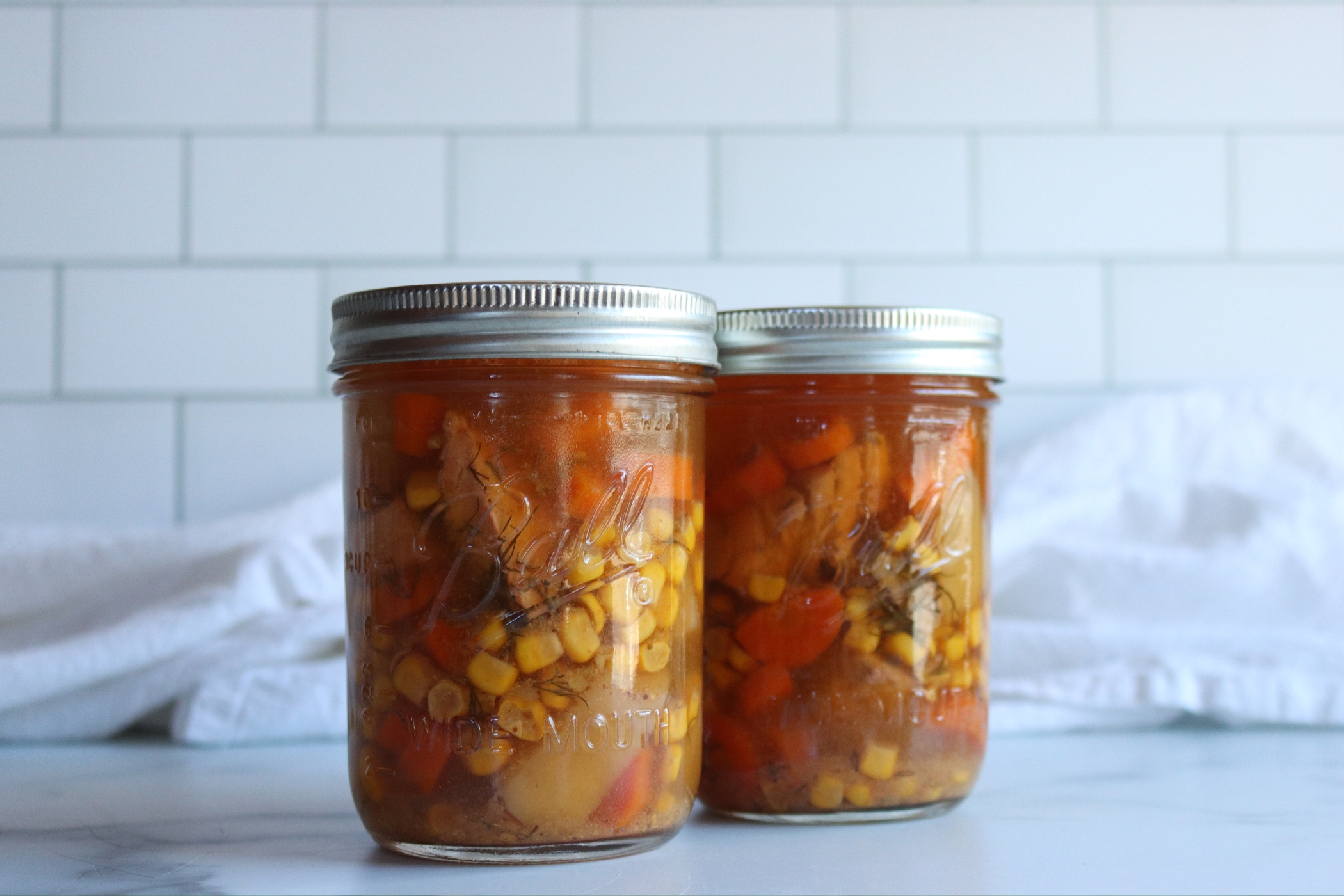
Ever wondered why restaurant chowders taste so good? It’s because they start with a rich, flavorful base. Imagine having that same deliciousness ready at home anytime you want.
That’s the magic of canning your salmon chowder base.
Canned salmon chowder base is a lifesaver for home cooks and food enthusiasts alike. Imagine coming home after a long day and having a delicious, hearty meal ready in minutes. With canned salmon chowder base, that’s exactly what you get. Just heat it up, maybe add a splash of cream or some fresh herbs, and dinner is served!
Plus, salmon is packed with omega-3 fatty acids, which are great for your heart and brain. The vegetables add fiber and essential nutrients. Plus, since you’re making it yourself, you control the quality of the ingredients – no preservatives or artificial flavors here!
Let’s face it, buying canned soups can add up, especially if you’re buying premium brands. By making your own, you’re not only saving money but also getting a superior product. When properly canned, your salmon chowder base can last up to a year in your pantry. That’s a whole year of quick, easy meals!
In this blog post, you’ll learn how to make and can your own salmon chowder base. We’ll cover the ingredients, the canning process, and even some serving tips to make your chowder experience delightful. Ready to get started? Let’s dive in!
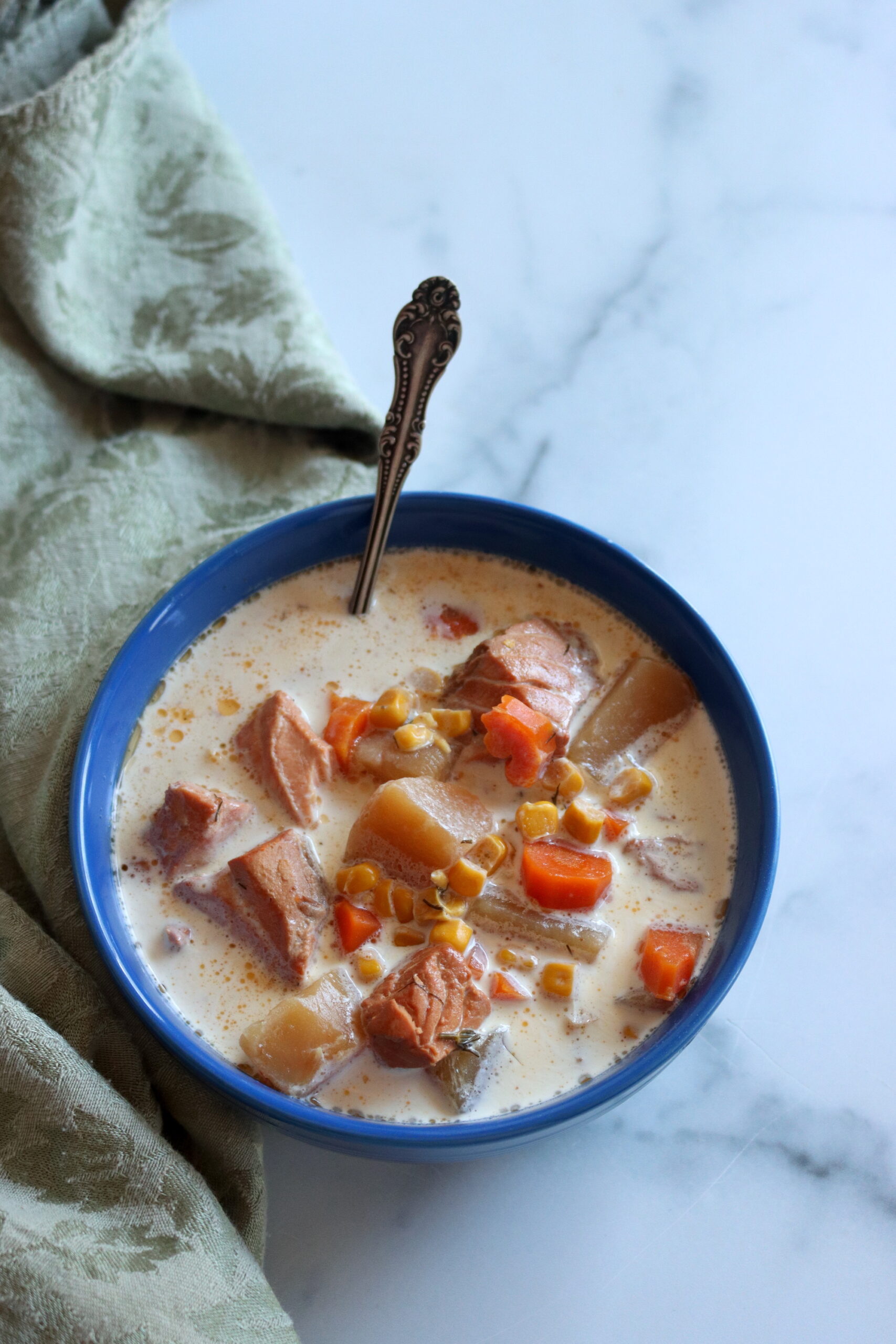
Ingredients for Salmon Chowder Base
This recipe is based on the University of Alaska’s Hearty Soup canning protocol. That guidance allows you to create your own soup canning recipe, provided you use their specific guidelines, times, and pressures. The ingredients for canning salmon chowder base are quite simple. To make a canner batch of six pints, you’ll need the following:
- 1 lb salmon
- 3 cups (1 lb) potatoes
- 1 1/2 cups corn (about 1 can)
- 1 cup carrots
- 1 cup onion
- 2 tsp old bay
- 2 tsp salt
- 1 tbsp fresh dill
- ½ tsp garlic powder
- 7 cups fish stock, chicken broth, or vegetable broth
- 1 cup dry white wine (or more broth)
You can choose to add bacon or heavy cream after canning when you cook the soup later on, but they can’t be added into the canning jars. A bit of lemon juice can also be added for extra zing, and that can be added before or after canning.
You can really add whatever you’d like to this base after canning it, but avoid changing the recipe before canning.
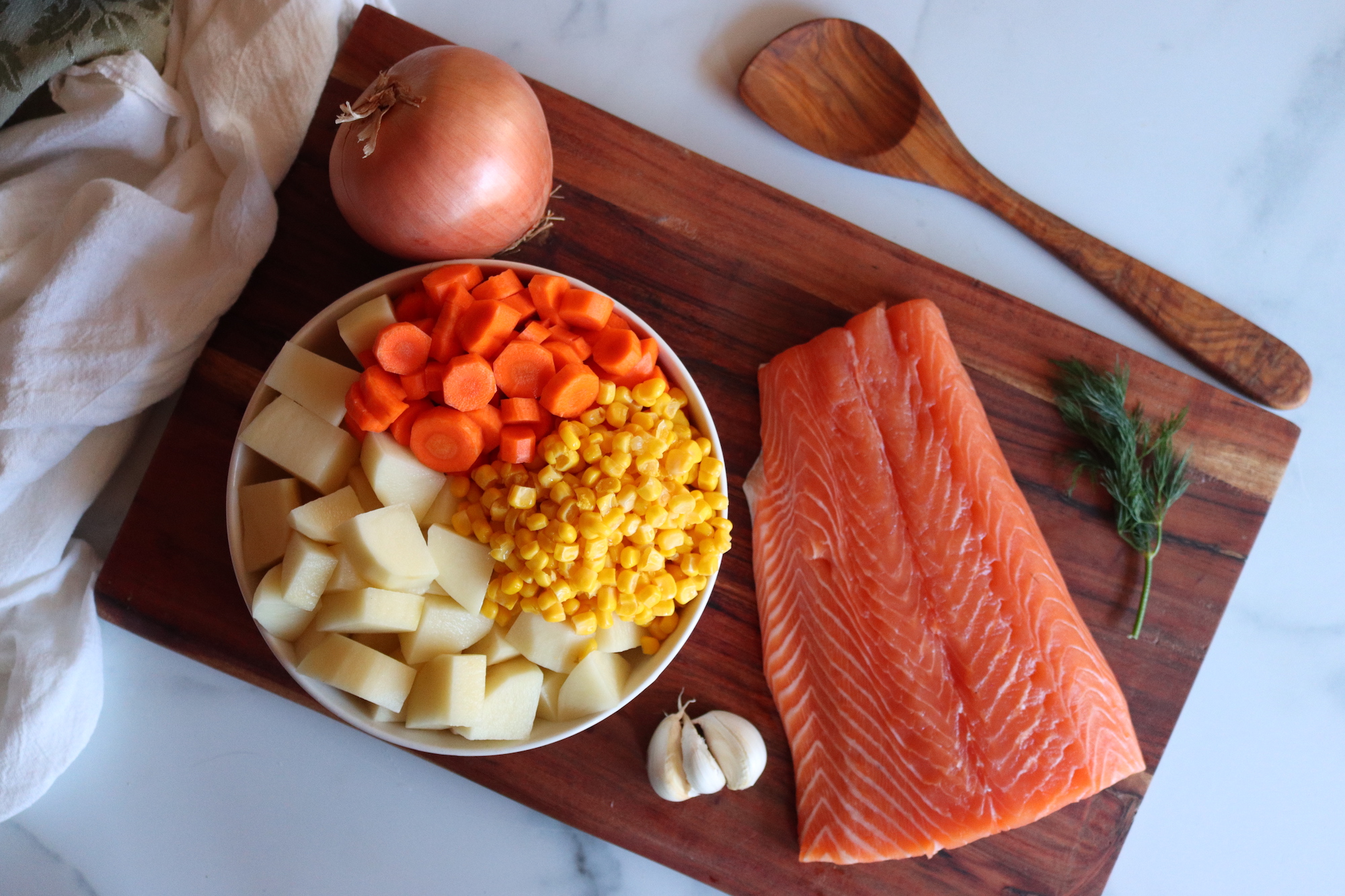
Canning Salmon Chowder Base
First, cut the salmon into bite-sized pieces. Don’t worry about small bones; they will soften during the canning process and you won’t even notice them. Peel and dice the potatoes, and chop the carrots and onions.
Combine all your ingredients in a large pan and cover with the broth and wine from the recipe (or water). Boil for five minutes. Add salt, herbs, and spices to taste, but keep in mind that their flavors will intensify during canning. Fill hot, clean canning jars, leaving one inch of headspace.
One note here – if the liquid in your jars turns cloudy after canning, it could be due to starchy vegetables like potatoes. Make sure to rinse them thoroughly before adding them to the chowder base. This is not dangerous and shouldn’t affect the safety of your canned salmon chowder base, but is just something to be aware of for aesthetic purposes.
Allow the canner to heat up, then vent steam for 10 minutes. Add the weight. Process the filled jars for 100 minutes at 11 lbs pressure in a dial gauge canner or 10 lbs pressure in a weighted gauge canner. Make sure you adjust the canning time if your pressure drops below the specific levels.
Once the canning time has finished, turn off the heat and let the canner depressurize on its own. After it reads zero, wait another 10 minutes, then remove the jars. Let them cool at room temperature for 24 hours, then check the seals, label, and store.
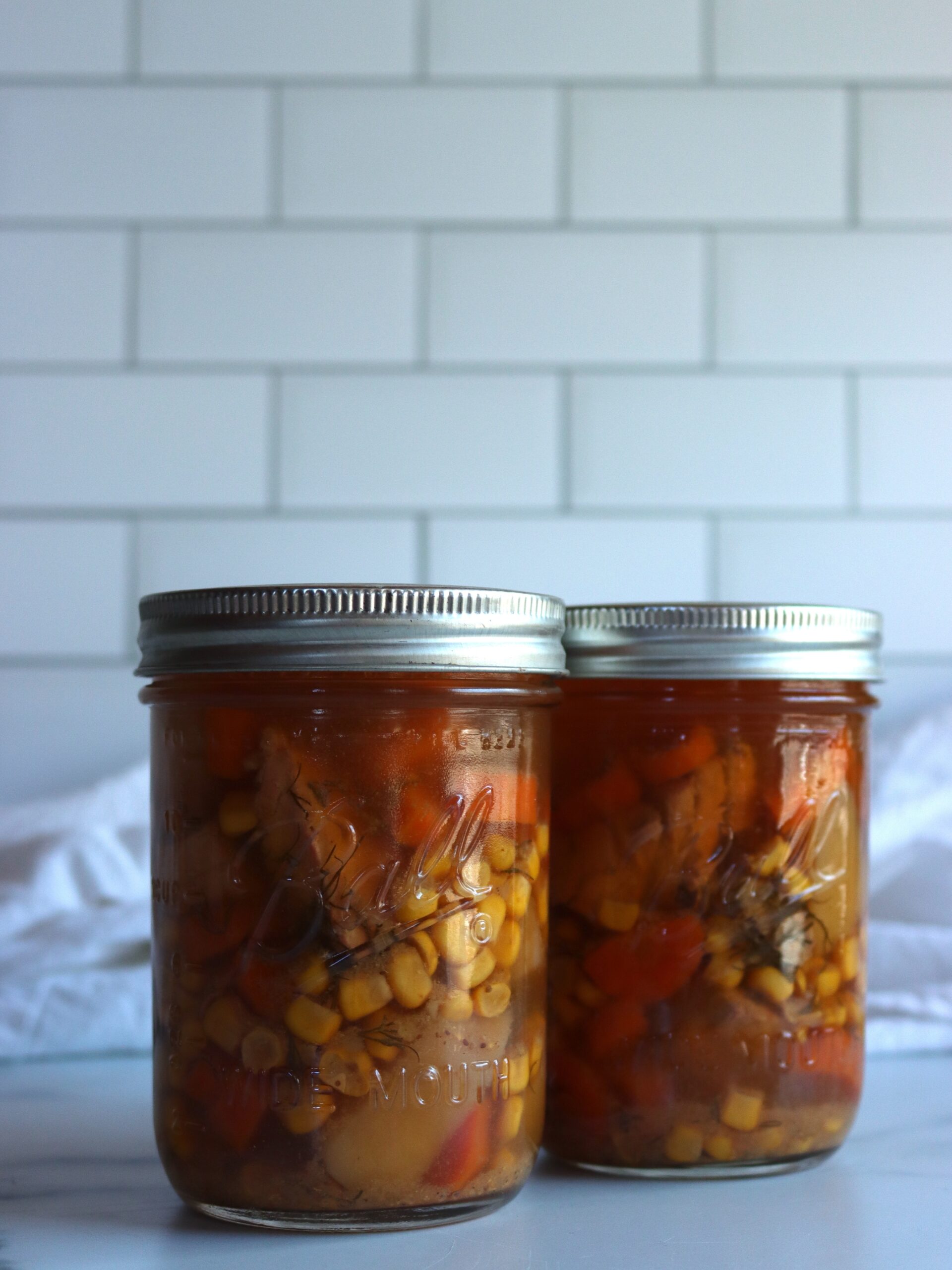
Altitude Adjustments
With pressure canning, the processing times stay the same at higher altitudes, but the pressures change. Here are the altitude adjustments for pressure canning salmon chowder base:
For dial gauge pressure canners:
- 0 to 2,000 feet in elevation – 11 lbs pressure
- 2,001 to 4,000 feet in elevation – 12 lbs pressure
- 4,001 to 6,000 feet in elevation – 13 lbs pressure
- 6,001 to 8,000 feet in elevation – 14 lbs pressure
For weighted gauge pressure canners:
- 0 to 1,000 feet in elevation – 10 lbs pressure
- Above 1,000 feet – 15 lbs pressure
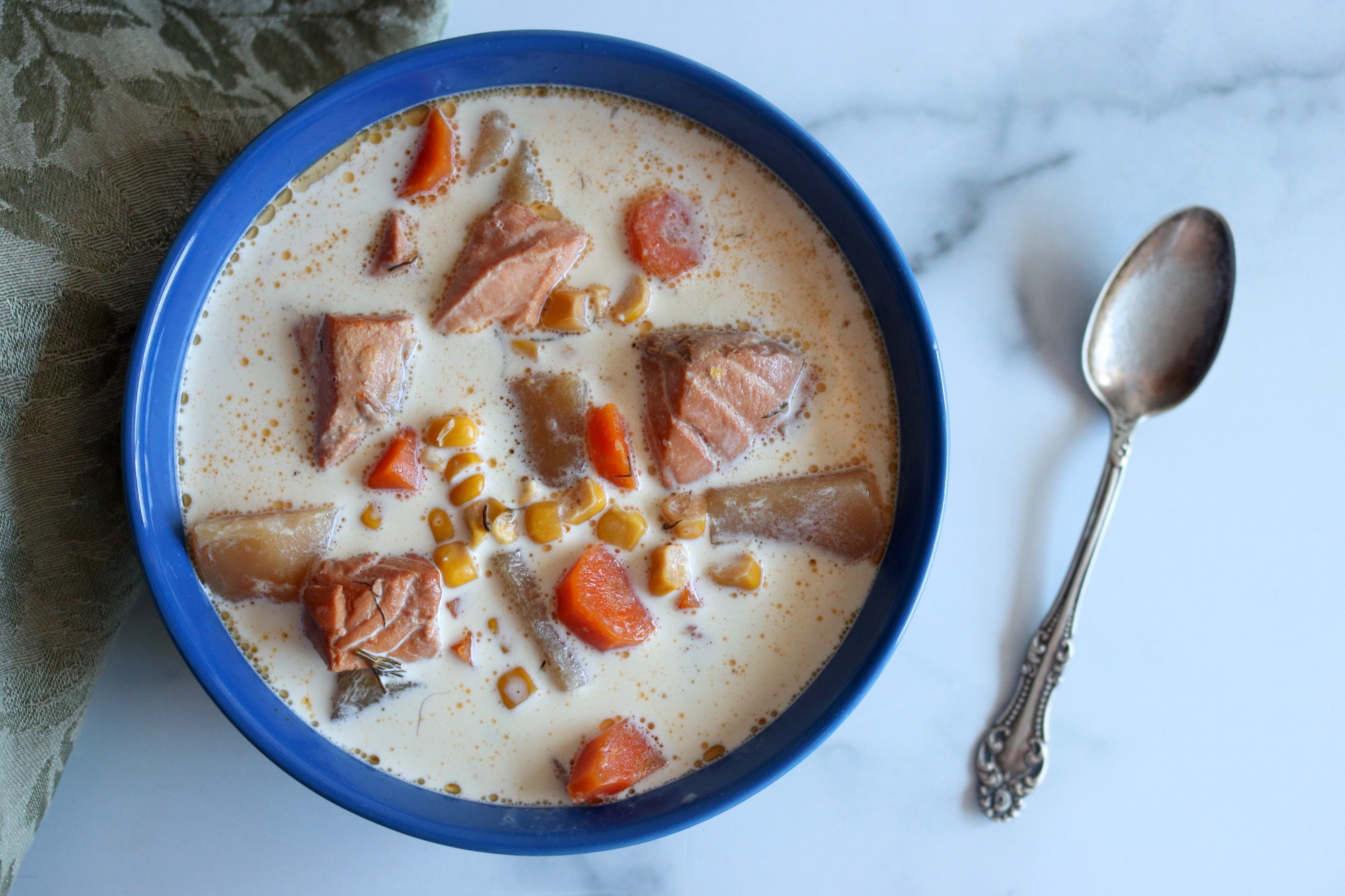
Serving Salmon Chowder Base
Once your chowder base is ready, serving it is a breeze. Canned chowder base is perfect for camping trips, picnics, or emergency food supplies. It’s a meal that’s ready to go wherever you are.
You can serve the chowder base as it is or add a splash of cream and some fresh dill for extra flavor. Here are a few more ideas to level up the base:
- Top with Fresh Herbs: Garnish with freshly chopped parsley, dill, or chives for a burst of freshness and color.
- Incorporate Bacon: As mentioned earlier, you can sprinkle crispy, crumbled bacon on top for added smokiness and crunch.
- Mix in Cheese: Stir in some shredded cheddar or a handful of grated Parmesan for a cheesy twist.
- Add Spices: For a bit of heat, consider adding a pinch of cayenne pepper or a splash of hot sauce.
- Include Vegetables: Toss in some sautéed bell peppers or peas for extra texture and color.
- Drizzle with Olive Oil: A light drizzle of extra virgin olive oil can enhance the richness of the chowder.
- Use Seafood Stock: Instead of regular stock, use seafood stock to amplify the chowder’s marine flavors.
- Top with Croutons: Add a handful of crunchy croutons for a delightful contrast to the creamy soup.
Whatever you choose, it’s incredibly versatile. You can pair it with saltine or oyster crackers, a soft and savory dinner roll, or crusty bread to dip right into the broth. A fresh salad goes wonderfully with salmon chowder, too.
My kids especially love this recipe with a batch of homemade buttery biscuits!
Fish and Seafood Canning Recipes
Looking for more ways to put up your catch right on your pantry shelf?
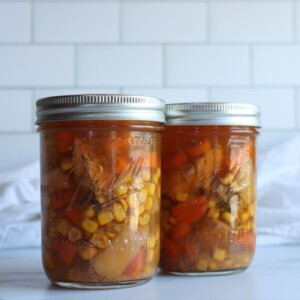
Canning Salmon Chowder Base
Equipment
Ingredients
- 1 lb salmon
- 3 cups potatoes, diced, about 1 lb
- 1 1/2 cup corn, about 1 can
- 1 cup carrots, peeled and chopped
- 1 cup onion, peeled and diced
- 2 tsp old bay
- 2 tsp salt
- 1 tbsp fresh dill
- ½ tsp garlic powder
- 7 cups fish stock, or chicken broth
- 1 cup dry white wine, or more broth
Instructions
- Cut salmon into bite-sized pieces, not worrying about small bones as they will soften during canning.
- Peel and dice potatoes, and chop carrots and onions.
- Combine all ingredients in a large pan and cover with hot water, broth, or wine.
- Boil for five minutes and add salt, herbs, and spices to taste.
- Fill hot, clean canning jars, leaving one inch of headspace.
- Heat up the canner and vent steam for 10 minutes.
- Process filled jars for 100 minutes at 11 lbs pressure in a dial gauge canner or 10 lbs in a weighted gauge canner, adjusting the pressure to your altitude.
- Turn off heat after canning time, let canner depressurize naturally.
- Wait for zero pressure, then an additional 10 minutes before removing jars.
- Cool jars at room temperature for 24 hours, check seals, label, and store properly.
Notes
Altitude Adjustments
With pressure canning, the processing times stay the same at higher altitudes, but the pressures change. Here are the altitude adjustments for pressure canning salmon chowder base:For dial gauge pressure canners:
- 0 to 2,000 feet in elevation – 11 lbs pressure
- 2,001 to 4,000 feet in elevation – 12 lbs pressure
- 4,001 to 6,000 feet in elevation – 13 lbs pressure
- 6,001 to 8,000 feet in elevation – 14 lbs pressure
For weighted gauge pressure canners:
- 0 to 1,000 feet in elevation – 10 lbs pressure
- Above 1,000 feet – 15 lbs pressure
Nutrition
Nutrition information is automatically calculated, so should only be used as an approximation.
Fish Canning Recipes
Salmon chowder base is perfect for quick, satisfying meals! Pair it with other soup recipes like Canning Nordic Salmon Soup or the versatile Canning Fish Chowder Base. For additional seafood options, try staples like Canning Tuna, gourmet choices like Canning Crab, or luxurious additions like shrimp from the full list in Fish Canning Recipes.
And, of course, canning plain salmon is also an option!
Soup Canning Recipes
Looking for more easy homemade soup-in-a-jar canning recipes?
- Canning Carrot Soup
- Canning Split Pea Soup
- Canning Sausage, Potato and Kale Soup
- Canning Chicken Soup
Soup Base Canning Recipes
Sometimes, you can’t get everything you love into a jar and still have it safe for canning. Soups that include thickeners or cream can be put up as soup bases, and then finished quickly on the stove. Try your hand at these delicious, time-saving soup bases:
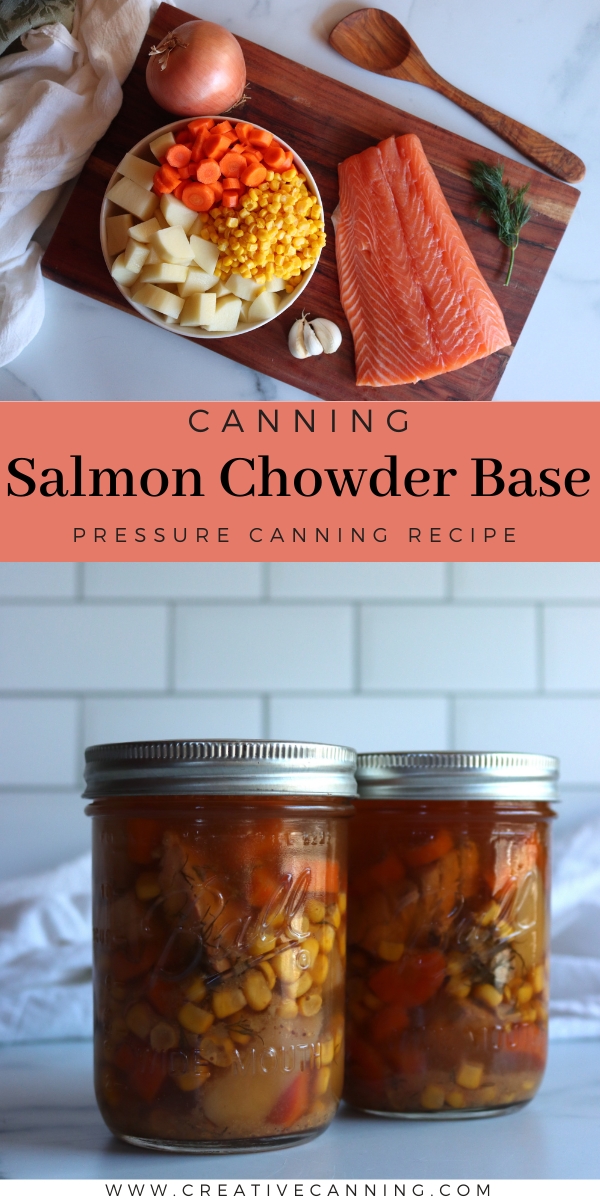
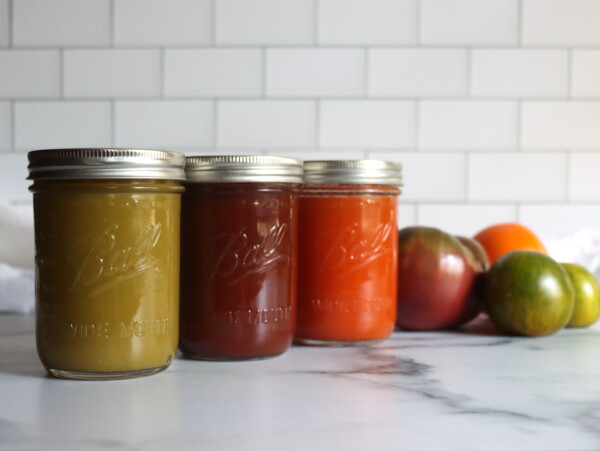
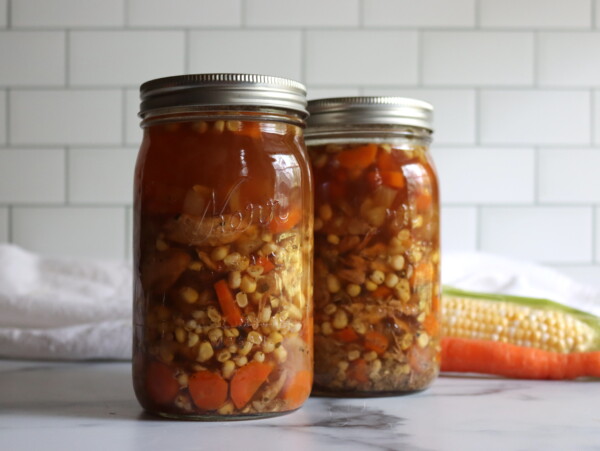
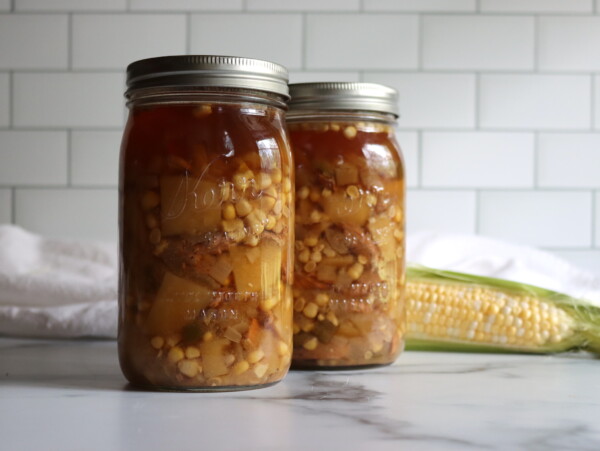
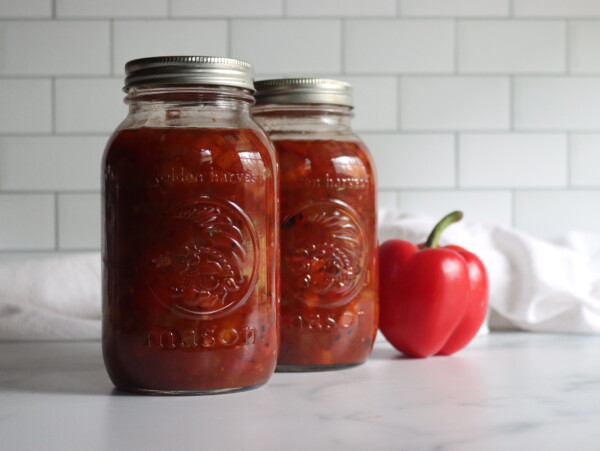
I made this last week and cracked open a jar after a couple of days and added heavy whipping cream, about 1/4- 1/3 C. My jars did have salmon fat/impurities floating around, so not as pretty as your jars. It was very good and hubby said he liked it and would enjoy it in the future. My only take is that the amount of broth is way too much. I easily had 4 cups left over. It only took about 3/4 C liquid to top off each pint. I ended up using half of the left over broth to make clam chowder, then froze the left over 2 cups for a future endeavor. Overall, a great base recipe! If you like thicker chowder, you could make a cornstarch slurry to thicken and add when heating up, but it is good without thickening. Great with biscuits or corn bread. Thanks for the recipe, Ashley!
Wonderful, so glad you enjoyed it! I’ll have to re-measure the broth next time I make this recipe. My kids love it, so it’s on the canning agenda again for this winter.